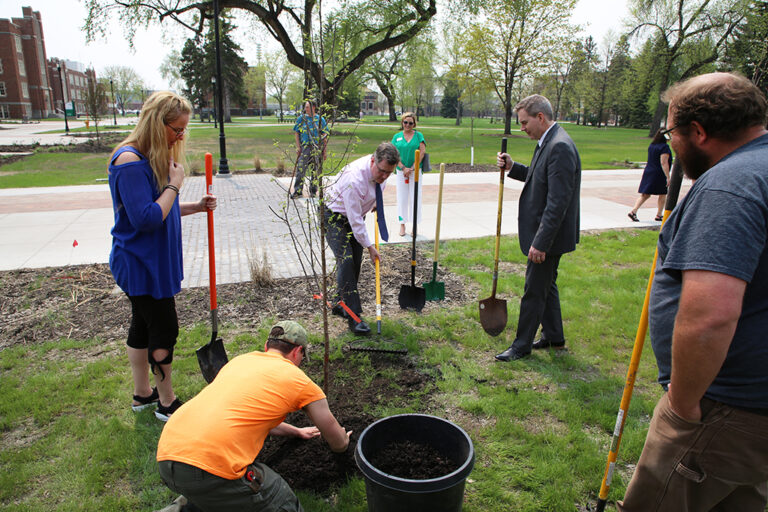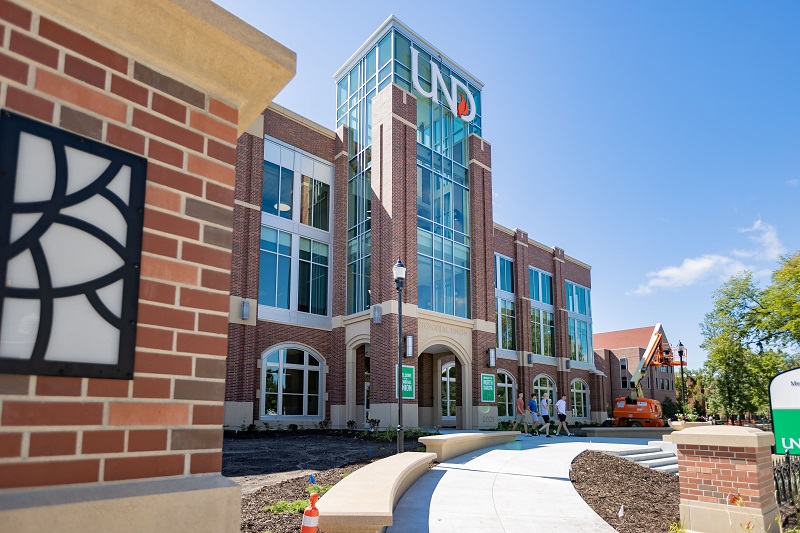Students join K-12 schools for field research on winter precipitation
Winter weather will mean more to some students at UND and area K-12 schools than ever before.
That’s because student researchers will be studying snowfall in the Red River Valley from Nov. 15 to Dec. 6 in a project titled “SNOwD UNDER (Student Nowcasting and Observations with the DOW at UND: Education through Research).
The project will be led and conducted by UND graduate and undergraduate students with participation from K-12 schools and guidance provided by University faculty.
More than 20 area primary and secondary schools have been invited to measure freshly fallen snow at their schools using the same technique used by official weather observers. By carefully measuring the snow depth that has fallen on a flat “snowboard,” UND student researchers will be able to properly correlate the data with radar and aircraft sensor observations of falling snow. This will allow better snowfall estimates in regions where only radar data is available.
Additionally, middle and high School students will be melting the snow into a liquid equivalent to calculate snow density. Snow density is defined as the water alone divided by the total volume (air plus water) and is important for understanding the snow’s growth conditions.
The following schools were already signed up as of Oct. 25: Sacred Heart High School, East Grand Forks; Riverside Christian School, East Grand Forks; Ben Franklin Elementary, Grand Forks; St. Michaels Elementary, Grand Forks; Holy Family Elementary, Grand Forks; Valley Middle School, Grand Forks; Devils Lake Middle School; Emerado (N.D.) High School; Stephen-Argyle (Minn.) Central High School; and Red River High School, Grand Forks.
Laura Munksi, director of the Dakota Science Center in Grand Forks, is facilitating the outreach between UND faculty/students and K-12 educators/students and has applied for funding to supply the K-12 schools with snow-measuring instruments.
“SNOwD-UNDER is a great example of the types of hands-on projects that we support that encourage a lifelong fascination and curiosity in science,” said Munski.
Led by graduate student field coordinators Andrea Neumann and Aaron Kennedy, UND students will coordinate several weather observation platforms during the study including UND’s polarimetric Doppler weather radar, weather research aircraft and a Doppler-on-Wheels (DOW) polarimetric mobile weather radar from the Center for Severe Weather Research in Boulder, Colo.
Students will later analyze those datasets along with those from NASA’s MODIS satellites, the UND Regional Weather Information Center’s Road Weather Research Field Site at Buxton, and the National Weather Services’ Doppler Radar near Mayville, N.D.
Josh Wurman, from the Center for Severe Weather Research in Boulder, will accompany the DOW radar to North Dakota and train students in its use.
“Using these instruments, students will gain invaluable educational experience in learning to plan and conduct field research”, said principle faculty mentor Matt Gilmore, an assistant professor of atmospheric sciences at UND who teaches “Radar Meteorology” and “Severe and Hazardous Weather.” “The project will generate a snow dataset to be used in student research for years to come.”
UND students in “Intro to Radar Meteorology” this semester participated in the project’s design.
Other UND faculty members involved in the project:
Professor Leon Osborne is teaching snow-forecasting skills to SNOwD UNDER student forecasters within his Synoptic Meteorology class.
Associate Professor Fred Remer is teaching students within his Broadcast Meteorology class how to produce a news story about SNOwD UNDER for UND’s live television program, Studio One. The class is also producing a training video on how to conduct snow measurements for K-12 schools.
Assistant Professor Gretchen Mullendore is having her students understand computer forecast model sensitivity within her Numerical Methods class.
Assistant Research Professor David Delene is training students to use aircraft instruments for investigating snowflakes inside clouds within his Measurement Systems class.
Associate Professor Mark Askelson is training students how to improve computer snowfall forecasts within his Atmospheric Data Analysis class and how to collect individual snowflakes for laboratory study.
Goals for the project include: gaining a better understanding of air motions in snow events in the Red River Valley; better estimation of snowfall using radar in the Red River Valley; teaching UND students how to conduct a field campaign; and teaching participating K-12 students how to accurately measure snowfall.
Participation in the project is open to all UND students. Interested UND students should contact snowd.under.volunteer@gmail.com
K-12 teachers interested in K-12 student participation should contact dakota.science@gmail.com
To follow the progress of the SNOwD UNDER project, visit the blog at http://snowdunder.blogspot.com/
SNOwD UNDER is supported by the John D. Odegard School of Aerospace Sciences, along with a grant from the National Science Foundation Facilities for Education (for DOW operations). More than 40 UND atmospheric sciences students are participating in the study, so far, including 15 graduate students and 26 undergraduates.
— Corey Amiot, Krista Cooley and Kevin Huyck, Atmospheric Sciences students.


